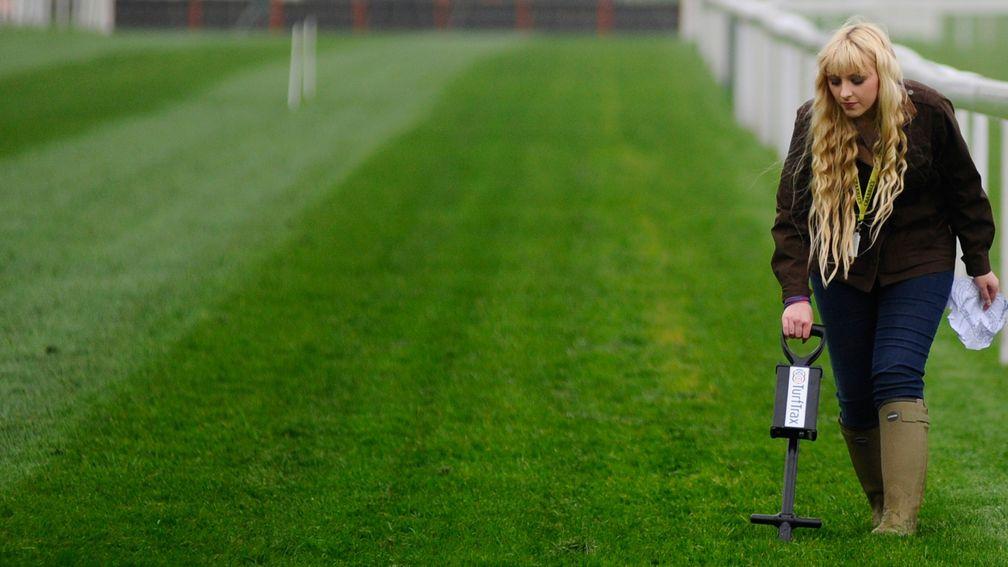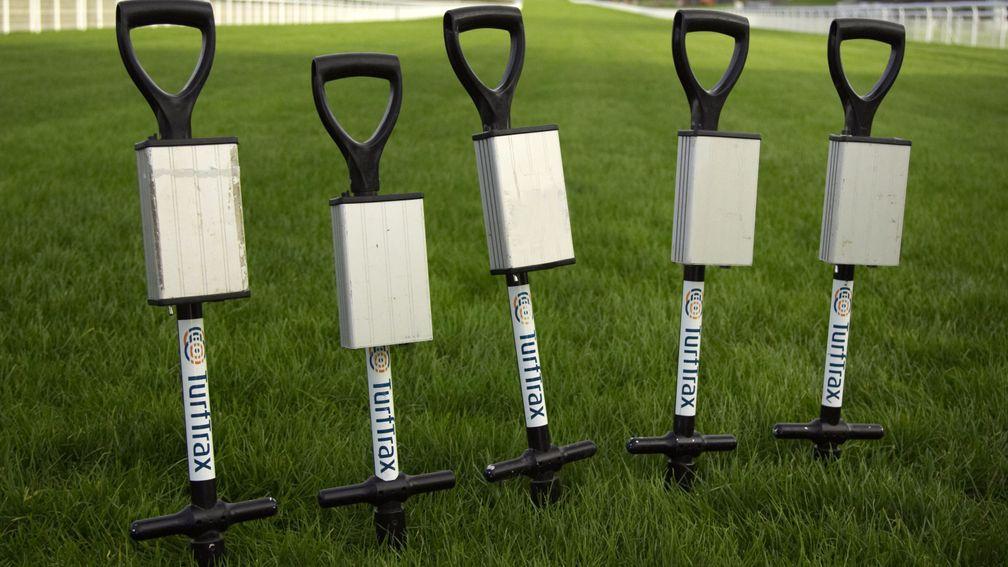Everything you ever wanted to know about the GoingStick

First published on Saturday, August 13, 2016
In a bid to introduce an objective and consistent measure of ground conditions, the use of the GoingStick has been mandatory on British racecourses since March 2007. Since that date, the official (but entirely subjective) assessment emanating from the heel of the clerk's wellies or the pointy end of their shooting stick has been supplemented by a numerical GoingStick reading.
After a decade of searching for a solution to an age-old problem, the Jockey Club – then racing's regulators – approached Cambridgeshire-based sports data company TurfTrax to create a cost-effective solution to finding a device for the systematic and objective assessment of going conditions.
In a project that started in 2000, other prototypes – like the penetrometer still in use in other countries, and the Clegg Impact Hammer – were not persevered with, leaving this curious cross between a spade and some weird electronic gizmo as the instrument of choice for recording the state of the going across Britain. Approximately £500,000 was spent in development.
The GoingStick guru
The invention of the GoingStick was a collaboration between TurfTrax, Cranfield University and the Jockey Club. A number of senior clerks of the course were also involved in the design, calibration and testing of the device, but if there is one person who can be described as the 'GoingStick guru', then it is TurfTrax managing director Mike Maher.
“When I joined the company in 2001 the GoingStick was already an idea, a prototype,” reports the self-effacing 41-year-old. “I did a lot of on-course testing but there were a lot of people involved.” Indeed there were. The GoingStick had to undergo a full-scale 12-month trial involving every British racecourse before it was adopted en masse.
Nothing like a penetrometer
You might consider the GoingStick as an upmarket, super-duper, pimped-up penetrometer: the user, after all, has to poke its bottom end (a tapered file) into the ground to get a reading. Don't suggest as much to Mike Maher, however. “It really is quite different,” claims the GoingStick pioneer. “It's sort of like comparing a penny farthing to a motor car. The penetrometer is antiquated in comparison – it doesn't record data electronically, and it only measures one of the things we're measuring.”
The GoingStick measures both the penetration (the amount of force required to push the tip into the ground) and the shear (the energy needed to pull back to an angle of 45 degrees from the ground). These two measures taken in combination represent a scientifically based proxy for the firmness of the ground and level of traction experienced by a horse during a race. The information is automatically stored in the GoingStick memory and an average of all readings can be provided instantly – and published.
Magic number 30
“We're advised that we need to take at least 30 readings at various points in a circuit for it to be statistically valid,” explains Andrew Cooper, clerk at Epsom and Sandown. “In terms of consistency of reporting information, you always try to take your readings in the same location on the track so you're comparing like with like. A lot of courses will have a marked number on the inside running rail but you know where they are anyway.” These are called 'waypoints'. With six readings at each waypoint – three vertical, three shear – the GoingStick therefore measures the mean average from at least 180 readings.
User-friendly
“It's a relatively straightforward piece of kit,” says Cooper. “You charge it up and go out on the course and take your readings.
“You put the stick into the ground three times, close to each other – within a couple of yards but not the same hole,” adds Cooper, who was involved in initial tests. “It measures downward penetration, how easily the probe goes into the ground vertically, and then you pull it back to a 45-degree angle to create a separate numerical reading – movement within ground, soil and grass, in some senses replicating what a horse's hoof would do. The machine stores the information and you go down the course to the next waypoint and do it again.”
Then, naturally, you turn it off and turn it on again. “After the end of the circuit, the GoingStick produces an average reading on a scale of 0-15,” says Cooper. A full circuit at Sandown takes about 45 minutes.

Highs and lows
The GoingStick produces readings on a scale of 0-15, where nought is the wettest ground imaginable and 15 is a tarmacked road. You won't see much outside the 5-10 range, and hopefully nothing below 3 or above 12, though it has happened.
On the Flat, the highest reading ever published was 12.8 at Thirsk on April 17, 2009, while Folkestone's 3.1 on April 1, 2008, was presumably little short of waterlogged. Over jumps, they managed 2.7 at Haydock on February 20 this year, while Taunton tops the charts at the other end of the scale with its 11.7 on March 25, 2009.
The GoingStick has separate calibrations for Flat and jumps, which are accessed with the flick of a switch. “You've got to be careful you get the correct setting,” says Cooper. “I admit at Sandown for the mixed meting in April on occasion I have gone out with the wrong one and done a couple of readings before I realised.”
Common misconception
A common misconception about the GoingStick is that its numerical readings correspond to distinct bandings of going descriptions. Admittedly, this is fairly confusing, because in simple terms, the lower the reading the softer/slower the ground and the higher the reading the firmer/faster the ground.
However, the specific GoingStick figure is subject to any number of course-specific variables and different tracks can produce different going descriptions - despite having the same reading on the GoingStick. This is because the verbal description offered by a clerk and the number produced by the GoingStick are essentially separate entities.
“The verbal description is still one person's subjective judgement whereas the GoingStick, at least in theory, is an objective measurement,” says NTF chief executive Rupert Arnold.
“One can't always relate the description to the reading – and sometimes trainers will criticise that, saying how can this reading be 'good' at this meeting and the same reading be 'good to firm' three weeks later? That's because one is objective and one is subjective. That can lead to misunderstandings, and a lot of criticism is based on that misunderstanding about how it works.”
This explains how, on July 27, Redcar and Leicester were both officially 'good to firm, good in places', yet the GoingStick was 9.0 at Redcar and 7.0 at Leicester. Mind you, that was a pretty extreme example.
. . . but it's not perfect
Nobody pretends the GoingStick is perfect. “People will have the odd criticism,” says Cooper. “I certainly wouldn't ever want to be putting out a GoingStick reading on its own; I think we need the verbal assessment as well.”
He adds: “We certainly haven't got to a situation across all the racecourses across the country where if a course gives out a reading of 7.5, a trainer or an owner can say, 'Ah, that means good ground'; in fact it could actually mean a very different going description between one course and another.
Or even at the same track within 24 hours. Look at the example of Chester on June 24-25: on the Friday, the ground was described as 'good to soft, good in places' with a GoingStick reading of 6.8. The next day, the official description had firmed up to 'good, good to soft in places' – yet the GoingStick read 6.5. “It can be quite user-specific – it depends how forcefully an individual pushes it in, so there can be a bit of a variation,” admits Cooper. “Some people are quite light-handed and some are a bit more heavy-handed.”
Four grand a go
If you fancy buying a GoingStick to measure the firmness of the turf in your back garden, a single new unit retails at £4,150, plus average annual service costs of around £500 per annum (which includes replacement of all parts). For that you'll receive a package also including download software, lead, charger, instruction manual and a handy carrying case. Each individual racecourse carries the cost of its GoingStick provision. There are options to lease and discounts for bulk or long-term orders.
More friend than foe
Without suggesting it offers any sort of nirvana, trainers generally welcome the GoingStick.

“Our overall view is that it is worth having because it is providing a set of data for trainers and punters to use,” says NTF chief executive Rupert Arnold. “But using them is not straightforward because they are so course-specific. The most useful way of using them is for historical information at a particular racecourse. I know trainers who use it – from their own experience, they know what a particular figure means for a particular racecourse.
“But if one person goes around a racecourse using a stick, they might produce a different figure from another person,” he goes on. “All these things show it is not ideal: it is not the perfect solution to a totally scientific measurement of going, and at the extreme end – either very firm or very soft ground – it starts to lose a little bit of accuracy. But overall trainers feel it is better to have it than not to have it.”
Ireland still to be persuaded
Britain is by no means the only nation to employ the GoingStick, which is in use to a greater or lesser extent across the racing world. There is, however, at least one notable exception: Ireland.
Although tests have been undertaken with the TurfTrax-patented GoingStick, Irish-based clerks of the course are still favouring a more traditional method.
"We don't use GoingSticks over here,” confirms Brendan Sheridan, clerk at the Curragh and Punchestown and one of the small, centrally based team that covers the nation's racecourses. “We contemplated it a few years ago and decided against it. All clerks of the course here use an ordinary wooden stick which they all find satisfactory."
TurfTrax managing director Mike Maher remains hopeful, however. "I think trainers who are used to seeing the readings when they bring horses to England are putting pressure on but they haven't taken that step yet," he says. "But we met one of the main Irish racecourses at Goodwood so I'm hopeful we'll start seeing readings there before the end of the year."
Elsewhere, racecourse officials appear more enthused. High-profile users include the Victoria Racing Club – the GoingStick has been at the Melbourne Cup since 2010 – plus Dubai, Hong Kong and California, where it is mandatory at Santa Anita and Del Mar. “Sometimes they use it in conjunction with other devices but there is a gradual move towards the GoingStick around the world,” says Maher.
There, though, still some way to go before TurfTrax can claim world domination. Use is sparse in France, where an updated penetrometer remains the norm, as it does in Germany and South Africa.
What the trainers say
Andrew Balding I sometimes use the GoingStick reading but my preference is to go on the description. I will use the GoingStick reading if I’m worried about a surface.
Tony Carroll I don’t pay much attention to GoingStick readings – they seem to differ on different soils.

Luke Dace I like to look myself and walk the course. It all depends on the texture of the soil – a clay surface can be completely different.
Gary Moore If you know your racecourses or the clerk of the course is someone you can rely on it’s not necessary to look at GoingStick readings but it can be a useful tool to help at racecourses I don’t know so well
Jamie Osborne I much prefer to talk to the clerk o the course; I don’ really use the readings.
Members can read the latest exclusive interviews, news analysis and comment available from 6pm daily on racingpost.com
Published on 25 August 2017inRP Classics
Last updated 12:20, 1 September 2017